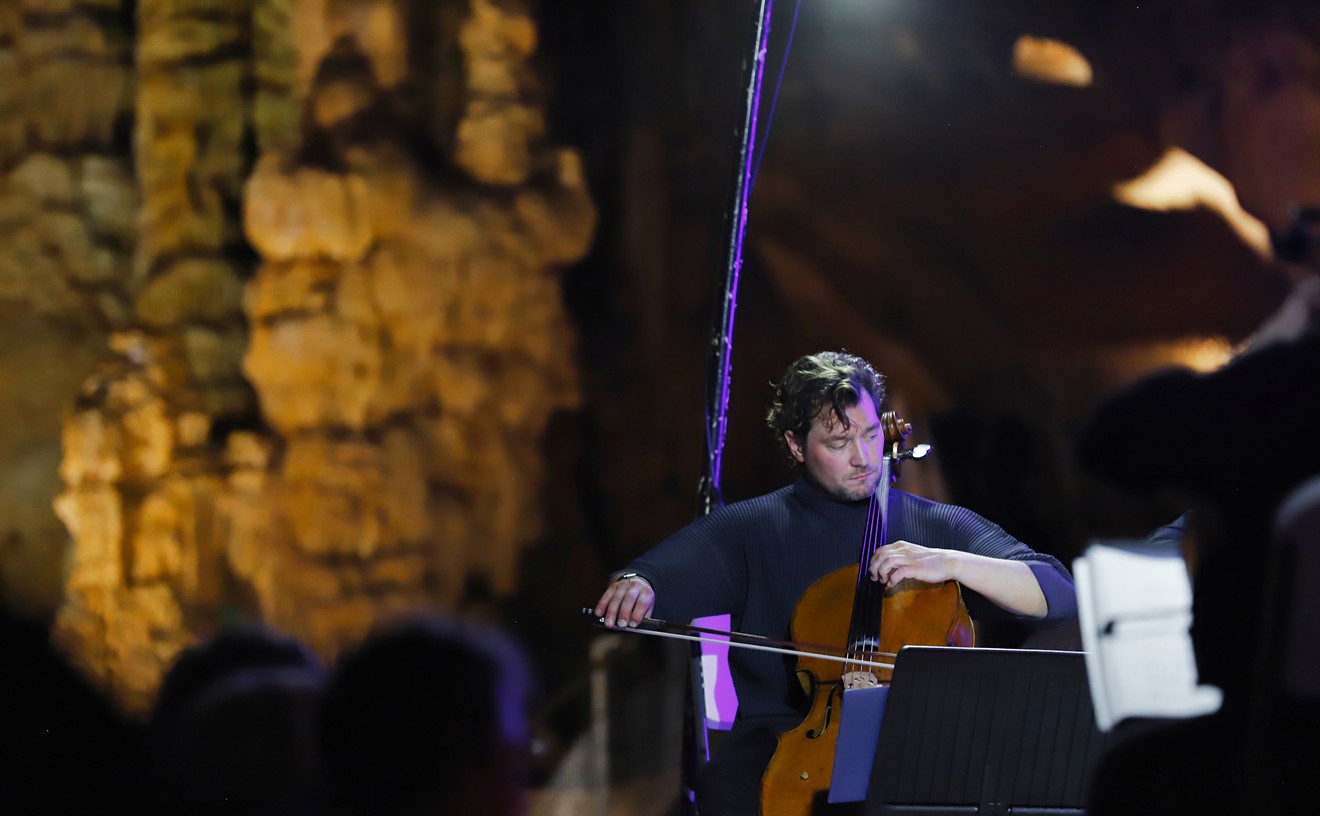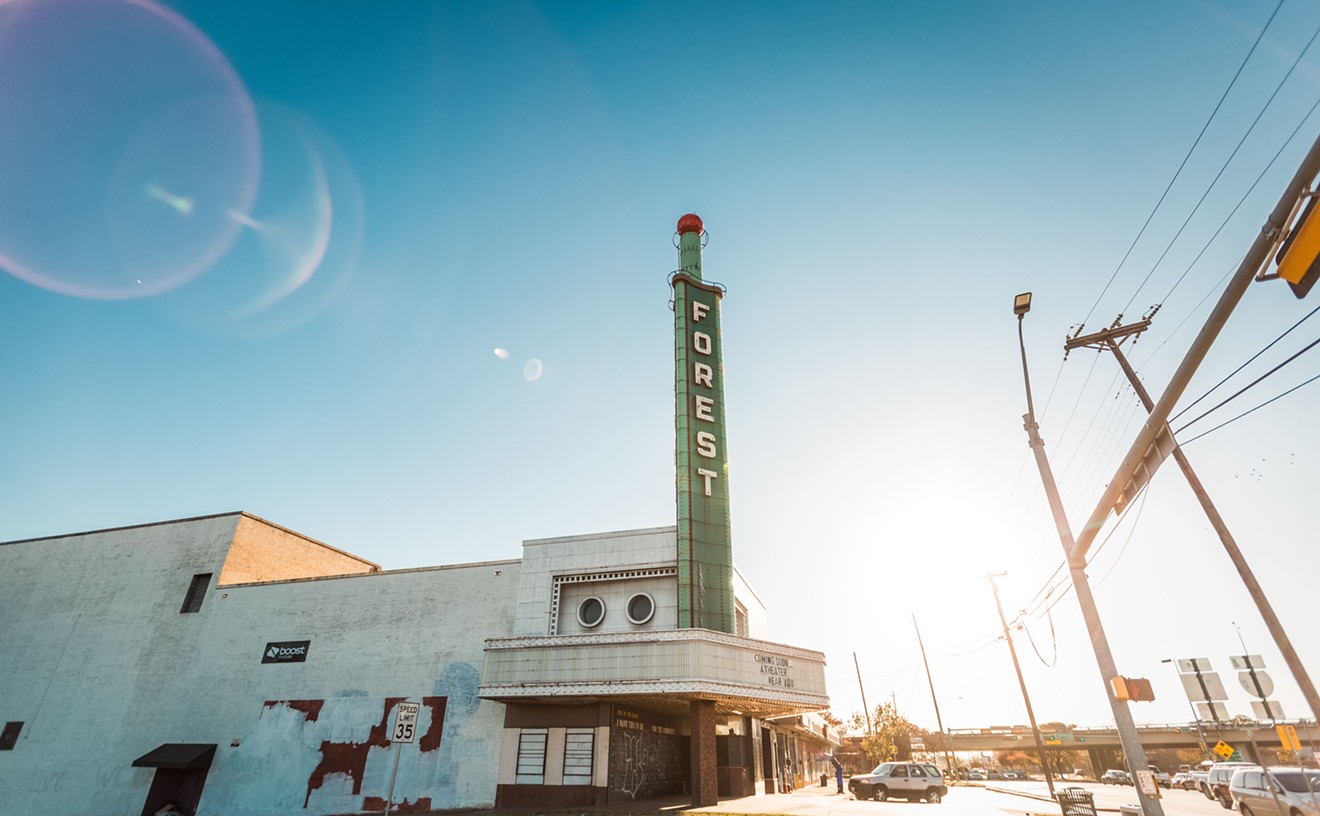On the left side of the painting, titled "Virgil, Quick, Come See," was a 1936 photo of Roosevelt’s great-grandfather, President Franklin D. Roosevelt, pulling a white ribbon to unveil a bronze, 7-ton sculpture of Confederate Gen. Robert E. Lee in Lee Park in Dallas. In the artist’s reimagining of the scene in the painting, the ribbon in the president’s hand flows up to the painting’s right half, where it’s serving another purpose: lifting the Lee statue up and off its giant pedestal, as depicted in a photo from The Dallas Morning News in 2017. The statue, of course, was indeed removed from the Dallas park in September of that year, after city officials decided it should no longer stand following a violent rally and the death of one person over similar Confederate statuary in Charlottesville, Virginia, a month earlier.
Laura Roosevelt had created "Virgil, Quick, Come See" as part of her current exhibition, presented by the Dallas Historical Society, called Historic American Pop — a collection of nearly 40 works on display at the Dallas Hall of State in Fair Park through April 14. "Virgil" never made it into the show. Roosevelt says it was “censored” from the exhibition by the historical society, which would not allow it to be included because it was too controversial. “To be honest, I was really surprised when they said no,” Roosevelt says. “I said, ‘But it’s art. I’m not making a political statement.’”
The historical society, for its part, disputes the idea that the painting was censored because it was controversial. Former Dallas City Manager Mary Suhm, who serves as chairman of the nonprofit organization, says there was limited space to hang paintings at the Hall of State, and "Virgil" didn’t fit in with the exhibition’s theme. In the meantime, word of mouth about the piece that didn’t make it into the exhibit has spread, and potential buyers have shown up at Roosevelt’s art studio near Fair Park to look it over. The Dallas Historical Society, she says, “just helped the value of this painting increase.” Texas Roots
Historic American Pop kicked off on March 21 at the Hall of State with a preview showing of Roosevelt’s art, as well as a panel discussion titled “From Hyde Park to Fair Park” by three grandchildren of the 32nd president and First Lady Eleanor Roosevelt, who was the niece of President Theodore Roosevelt.
Moderated by Paul Sparrow, director of the Franklin D. Roosevelt Presidential Library and Museum in Hyde Park, New York, the panel event included Elliott “Tony” Roosevelt Jr., who is Laura’s father. Tony’s father, Elliot Roosevelt, the second-oldest son of Franklin and Eleanor, married a Texas woman named Ruth Googins, and the couple lived on a ranch in Benbrook, southwest of Fort Worth, where Franklin and Eleanor often visited.
During the panel discussion, which drew about 200, the grandchildren seemed to reminisce mostly about Eleanor, whom they grew to know during visits to the Roosevelt home in southeastern New York state. They lavished praise on the first lady, a progressive who was an outspoken supporter of social and racial justice and an active participant in her husband’s administration, for her sense of duty and her willingness to listen to people.
Laura Roosevelt, who’s 59, was born in Fort Worth and grew up in Dallas, where she became interested in art in the seventh grade and attended Ursuline Academy. After earning a bachelor’s degree in art history and studio art from Denison University in Ohio, and then a master’s in art/art studies from New York University, she reared three children in Connecticut and worked in the print and Latin American painting departments at Sotheby’s. She began painting full time about 15 years ago and returned to Dallas to live in 2017.
While she calls herself an abstract artist — her paintings and sculptures can be seen online at lrarthouse.com, and at the EC Dicken showroom in the Dallas Design District — her Historic American Pop collection takes a different tack. Inspired, she says, by artists like Andy Warhol, Jasper Johns and Clifford Still, as well as her love of history, the works combine iconic historical photos and her own abstract, textured layering techniques. The intent is to say something new and relevant about those moments that were captured in time.
The exhibit’s centerpiece, called Texas Centennial Exposition, depicts FDR speaking at the newly opened Centennial Exposition at Fair Park’s Cotton Bowl on Friday, June 12, 1936. About 50,000 people were on hand that morning for the president’s 30-minute talk, which was broadcast on radio nationally and ended with these words: “I salute the Empire of Texas.” Later, FDR and Eleanor were guests at a luncheon at the Adolphus Hotel before attending the Lee statue unveiling in the afternoon. They ended the day at Elliott’s Benbrook ranch.
In addition to historical photos of the Roosevelt family — FDR with Joseph Stalin and Winston Churchill; Eleanor with President John F. Kennedy; Theodore Roosevelt grinning after being shot in the chest in Milwaukee — the Hall of State show includes works depicting the likes of President Lyndon B. Johnson, Martin Luther King Jr. and Abraham Lincoln. The latter, called "Unity," features a photo-portrait of Lincoln superimposed over two flags you can just barely make out: Old Glory and the Confederate battle flag. Each painting is accompanied by a quotation from FDR or Eleanor that was selected by Laura’s sister, Elizabeth Roosevelt Kelly, or their late aunt, Chandler Roosevelt-Lindsley.
‘Recording History’
Roosevelt says she spent about a year creating new pieces for the Hall of State exhibit. The show had its origins in conversations between her and Suhm, the historical society chair, who lives in the building where Roosevelt has her art studio. The title of the painting that didn’t make the cut, "Virgil, Quick, Come See," was taken from The Band’s 1969 song, "The Night They Drove Old Dixie Down," a groundbreaking work of Americana music written by Levon Helm and Robbie Robertson about the last days of the Civil War. What the singer wants Virgil to come see, quick, is Gen. Robert E. Lee. “I brought 'Virgil, Quick, Come See' to be installed in the Hall of State with all the others,” Roosevelt recalls. “Then I went to Washington, D.C. When I got back from Washington, they told me, ‘This can’t be in it.’ I said, ‘Why?’ They said, ‘Because it’s too controversial.’ They thought it would put the show in a bad light. But, I was fine with it. So I replaced it with a Vietnam War painting called 'Our Boys.'
“I was really surprised when they said no. I said, ‘But it’s art. I’m not making a political statement.’ ” – Laura Roosevelt
tweet this
“I was tasked with the theme, From Hyde Park to Fair Park. I had two other images I was considering using. I decided that (Virgil) and the Centennial piece were the way it should go,” Roosevelt goes on. “I’m not making a statement one way or another. I was recording history — when FDR was here in 1936, and what he did. I had a lot of photos to work with, and I thought this one was very interesting over some of the others. I chose this to record, because it was ‘then and now.’ I was showing the facts. It tells about a moment in time.”
Suhm has another recollection. “The connection (of Roosevelt’s art exhibit) was to the opening of the 1936 Texas Centennial at Fair Park,” she says. “The connection was to that site and that building. She has lots of work, and we couldn’t exhibit all of it. She was pleasant about all the discussions we had.” Besides Suhm, the chief officers of the Dallas Historical Society are Karl Chiao, its executive director, and former Dallas City Council member Veletta Lill, its president.
Roosevelt was wary about being interviewed for this story. That’s because, she says, the historical society overall was “very gracious” to her in their dealings. However, she points out that she sits on the board of The Better Angels Society, an educational nonprofit supporting documentary filmmaking that was founded by filmmaker Ken Burns. Burns made a 14-hour documentary about Theodore, Franklin and Eleanor Roosevelt that was shown on PBS in 2014.
“I’m not a political-activist artist. But I don’t believe you can whitewash history,” Roosevelt says. “We need to have ‘civil discourse,’ as Ken Burns often says. I made the object around which the conversation can happen, maybe. Civil discourse would make me very happy. I think it would make my great-grandmother happy, too. She didn’t shy away from anything.”












